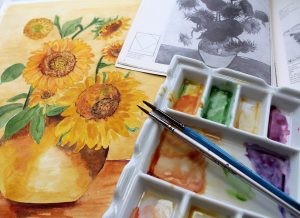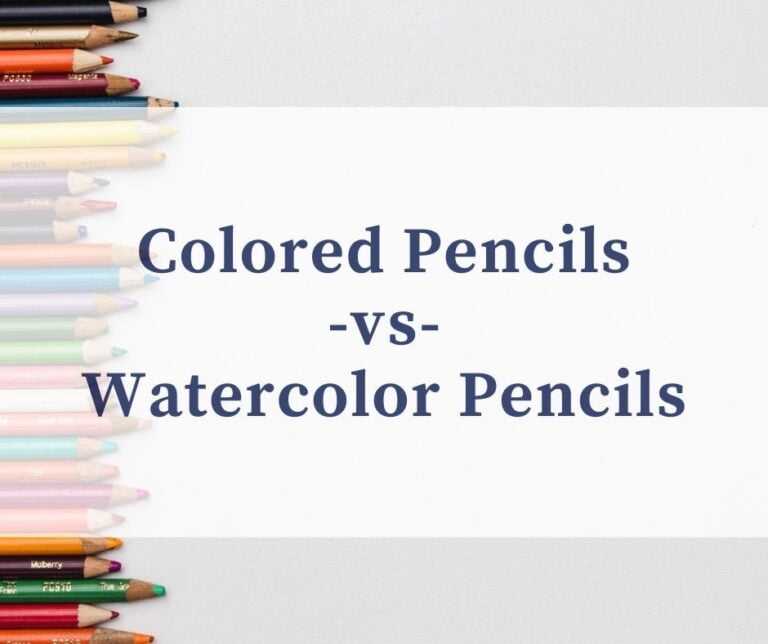Best Palette For Watercolor Painting To Easily Blend Colors
Often when you buy a watercolor set the pans come in a container that can function as a palette as well.
Unfortunately, often times this palette is a little limiting because the container is very small or there aren’t enough paint well.
That’s why many professional artists have several watercolor palette that they can rotate through.

There are some great models out there, but there are also many palettes that leave much to be desired. In this article you’ll learn what to look for and what the best palettes for watercolor are.
What To Look For In A Watercolor Paint Palette?
There are a few things you want to look for in your watercolor palette. Similarly, there are a few things that are marketed as pros but don’t really make a difference.
Let’s first look at the most important factors to consider:
#1 Studio Or Portable Palette?
First you want to consider if you will be travelling with your palette a lot or if you will only use it at home or in a studio.
Some studio palettes are made out of heavy materials such as porcelain, are rather big, and don’t always come with a lit. All these things make it difficult to travel with a studio palette. On the flip-side, the extra space and paint wells that a studio provides makes storage and mixing much easier.
Portable palettes are normally made out of lightweight materials such as plastic and come with a closing lid. However, since they are also considerably smaller you don’t have much space for mixing.
#2 The Number Of Ink Wells
Obviously the more well you have the more different mixed colors you can at once. Since watercolors can easily be reused even after drying, a palette can function not only as a space for mixing colors but also for storing them.
If you are just starting out you might be inclined to start with a palette that is a little on the smaller side. Those big ones are quite intimidating and who needs all that space anyways, right?
But as your skills progress you will certainly start using more colors and wish you had a bigger palette. So try to find a good balance between what you need right now and what you might want in the future.
#3 Cover
If you are looking for a portable palette, I would recommend you to go with one that comes with a cover.
However, a closing lid can be useful even if you are using a studio palette that you don’t plan on travelling with. For example, it will keep any dust or hair out of your precious paints.
Although I personally prefer to use watercolor palettes with a cover, they are not absolutely necessary. I have seen plenty of other artists that use some plastic wrap or aluminium foil to keep their paints safe.
What You Want To Stay Away From
A palette that is more expensive is definitely not always better. There are a few things you want to look out for to make sure you aren’t paying too much for unnecessary features.
#1 Expensive Materials
Watercolor palette can be made out of plastic, metal, ceramics, and other materials. As you can probably guess, the plastic is the cheapest option out there and people often associate it with bad quality.
However, there are many types of plastic and I actually recommend most people to go with a plastic palette.
A metal or ceramic palette certainly looks nice, but when it comes to mixing colors they don’t behave very different from any plastic palette.
If you are experiencing some problems with beading or separation of the paint on a plastic palette, you can try roughing the surface with a some steel wool or eraser before use.
Some watercolors can stain the plastic surface of your palette. However, normally these stains don’t influence or blend with any paint you might mix in the future.
#2 Airtight Covers
I already mentioned that I’m a big fan of having a palette that comes with a cover. However, this cover doesn’t need to airtight.
When you are using oil or acrylic paint having an airtight cover is great to prevent your paint from drying out.
However, if you are using watercolor paint this is no problem because they are easily rewetted by adding some water without loss of quality.
Top 3 Best Palettes For Watercolors
#1 Mijello Martin Palette For Beginners
This Korean brand has come out with a variety of innovative palettes that are very affordable.
This particular palette contains 18 color wells, 2 large mixing areas, and a removable clear style tray that can also be used for mixing.
One great advantage is that it has all the wells on one side of the palette, so you can even close it while the paint is still wet. All of these factors make this a great watercolor paint palette for beginners.
#2 Pro Art Folding Watercolor Palette For Travel
This palette by Pro Art is great if you are looking for a watercolor palette for plein air painting.
What makes this palette special is that is comes with a thumb hole, so you can easily hold it in one hand while painting. Which makes it also great for watercolor painting on a canvas and easel.
Next to the thumb hole are 5 smaller holes that can be used as brush holders. Additionally, it has 24 color wells and 5 big mixing areas.
#3 John Pike Watercolor Studio Palette
If you are looking for a studio palette that has plenty of space for mixing, you might want to take a look at this large plastic palette by John Pike.
Coming at 16″ x 12″ it contains 20 paint wells around the edges and a large mixing area in the middle.
Since it is made out of thick plastic, it doesn’t bend as easily as some cheaper palettes.
If you are taking any watercolor classes, there is a big chance that this palette might be recommended by your instructor.

